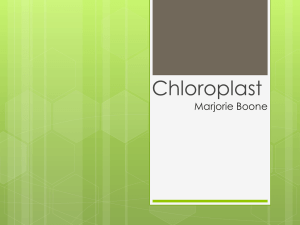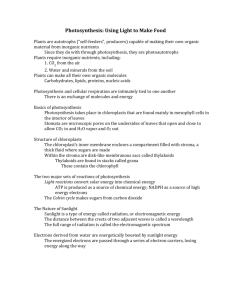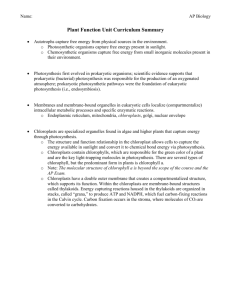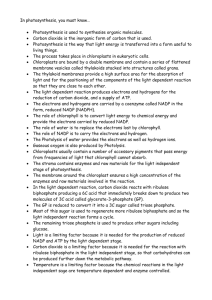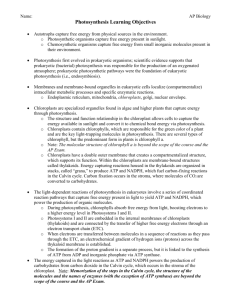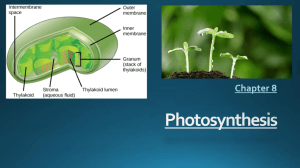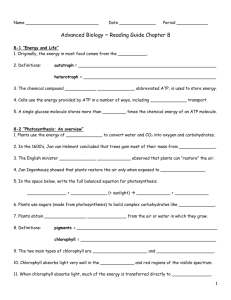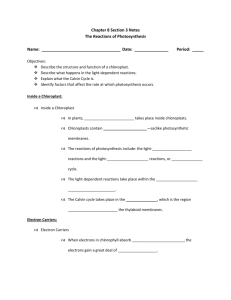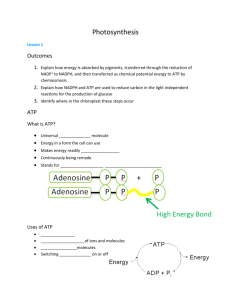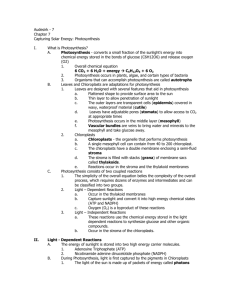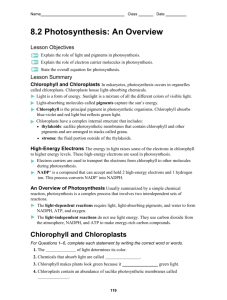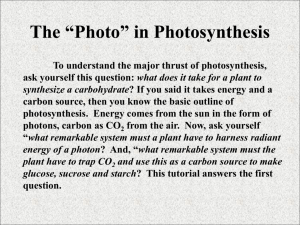Chloroplast & Energy Notes
advertisement
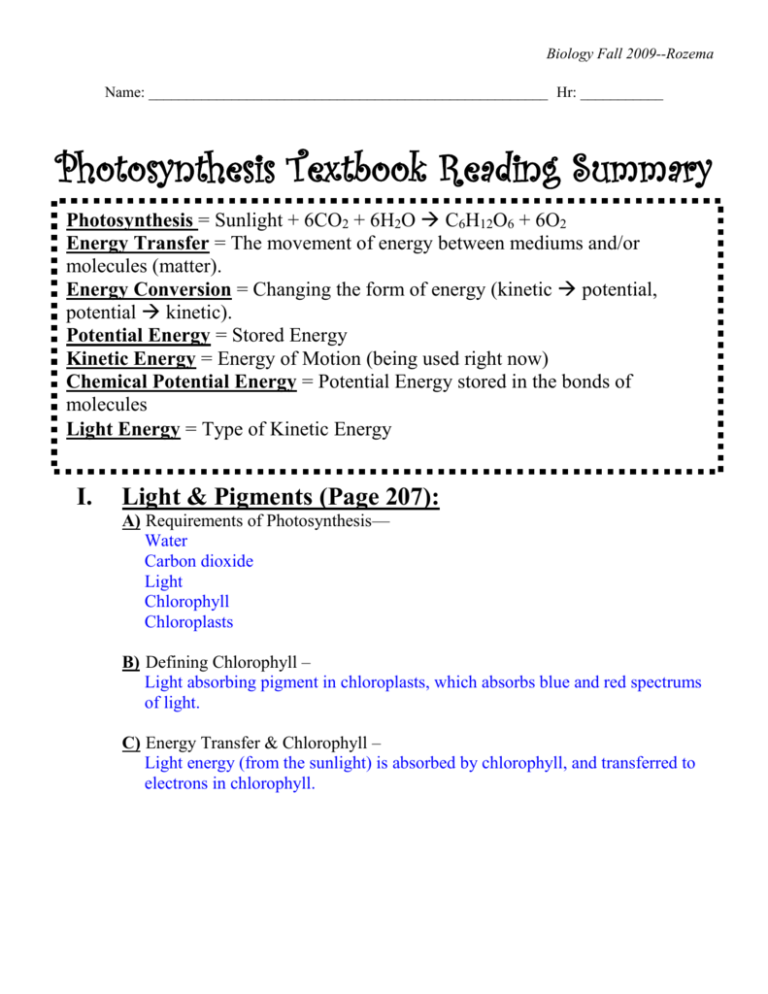
Biology Fall 2009--Rozema Name: _____________________________________________________ Hr: ___________ Photosynthesis Textbook Reading Summary Photosynthesis = Sunlight + 6CO2 + 6H2O C6H12O6 + 6O2 Energy Transfer = The movement of energy between mediums and/or molecules (matter). Energy Conversion = Changing the form of energy (kinetic potential, potential kinetic). Potential Energy = Stored Energy Kinetic Energy = Energy of Motion (being used right now) Chemical Potential Energy = Potential Energy stored in the bonds of molecules Light Energy = Type of Kinetic Energy I. Light & Pigments (Page 207): A) Requirements of Photosynthesis— Water Carbon dioxide Light Chlorophyll Chloroplasts B) Defining Chlorophyll – Light absorbing pigment in chloroplasts, which absorbs blue and red spectrums of light. C) Energy Transfer & Chlorophyll – Light energy (from the sunlight) is absorbed by chlorophyll, and transferred to electrons in chlorophyll. Biology Fall 2009--Rozema II. Inside a Chloroplast (Page 208): A) Defining Chloroplast— A cellular organelle which completes photosynthesis. B) Defining Thylakoids— [Inside chloroplasts] Saclike (coinlike) photosynthetic membranes which contain chlorophyll, and absorb necessary light energy. C) Defining Photosystems— [Inside chloroplasts] Organized clusters of light absorbing pigments, such as chlorophyll, within the thylakoids. D) Defining Stroma— [Inside chloroplasts] Empty space, or region around the thylakoids, which produces the high energy glucose molecules. E) Label the Diagram of a Chloroplast: STROMA THYLAKOIDS Biology Fall 2009--Rozema III. Electron Carriers (Page 209): A) Defining “Electron Carrier”— A molecule which can “take” a pair of high energy electrons (valence electrons), and will efficiently transfer them to other molecules in need of energy! B) Describe an Analogy for an “Electron Carrier”— Like using a pan to carry super hot coals…. Chloroplasts use NADP+ to carry super energized electrons! C) Function of NADP+--Take on 2 high energy valence electrons and a hydrogen ion. The light energy (from sun) is now trapped as potential energy in the chemical bond of the new NADPH molecule! D) NADP+ versus NADPH— NADP+ = Molecule without extra electrons and hydrogen. NADPH = Same molecule but with 2 electrons and 1 hydrogen added. IV. Light Dependent Reactions (Page 210 + 211): A) Defining “Light Dependent Reactions”— - The portion of photosynthesis which requires light and water to produce oxygen gas, and convert ADP and NADP+ into the energy carriers ATP and NADPH. B) Location of Light Dependent Reactions— Thylakoid membranes in chloroplasts. C) ATP Formation— - When Hydrogen ions react with ATP synthase (ATP enzyme machine), ADP is converted into ATP. - Occurs during Light Dependent Reactions in Thylakoids. Biology Fall 2009--Rozema V. The Calvin Cycle (Page 212 + 213): A) Defining “Calvin Cycle”— The portion of Photosynthesis in which ATP and NADPH (made during the light dependent reactions) are used to make glucose from carbon dioxide! B) Location of Calvin Cycle— Stroma of the chloroplast. C) Producing a 6-Carbon Sugar— - The carbons from carbon dioxide are used to form the 6carbon glucose molecule. - Energy from ATP and NADPH are used to form the 6carbon sugar molecule, storing their energy as potential energy in the bonds of the sugar molecule! OTHER IMPORTANT NOTES: - Plants take in water through their roots (at the bottom of the plant). - Plants take in Carbon Dioxide through tiny openings in their leaves called “stomata” (plural). - A stoma is surrounded by “guard cells” which open and close to allow carbon dioxide in. When the guard cells are filled with water, they blow up, expand, and push open, revealing the opening (stoma).
